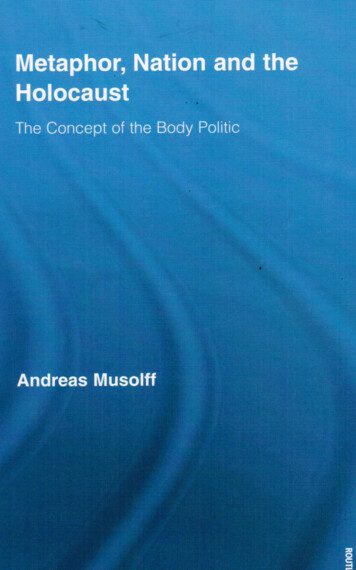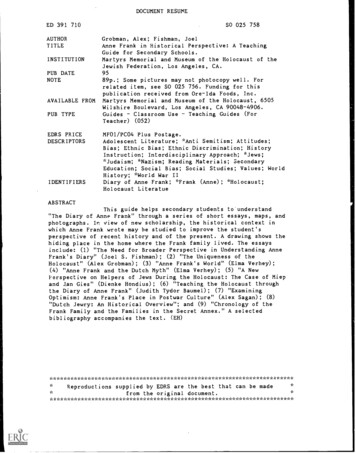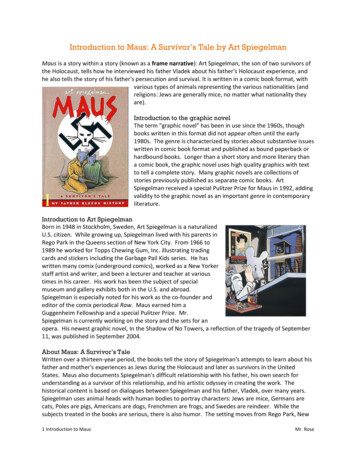
Transcription
Metaphor, Nationand the HolocaustThe Concept of the Body PoliticAndreas MusolffI o ;n upNew York London
First published 2010by Routledge270 Madison Avenue, New York, NY 10016Simultaneously published in the UKby Routledge2 Park Square, Milton Park, Abin don, Oxon OX14 4RNRoutledge is an imprint of the Taylor & Francis Group, an informa business 2010 Taylor & FrancisThe right of Andreas Musolf to be identified as author of this work has been assertedby him in accordance with sections 77 and 78 of the Copyright, Designs and PatentsAct 1988.'Typeset in Sabon by IBT Global.Printed and bound in the United States of America on acid-free paper by IBT Global.All rights reserved. No part of this book may be reprinted or reproduced or utilisedin any form or by any electronic, mechanical, or, other means, now known or hereafter invented, including photocopying and recording, or in any information storage orretrieval system, without permission in writing from the publishers.Trademark Notice: Product or corporate names may be trademarks or registered trade-marks, and are used only for identification and explanation without intent to infringe.Library of Congress Cataloging-in-Publication DataMusolf , Andreas.Metaphor, nation and the holocaust : the concept of the body politic I by AndreasMusolff.p. cm. - (Routledge critical studies in discourse ; 3)Includes bibliographical references and index.1. Discourse analysis-Political aspects. 2. Metaphor. 3. Analogy. 4. Holocaust,Jewish (1939-1945) I. Title.P302.77.M874 2010320.01 '4-dc222010002457ISBN13: 978-0-415-80119-5 (hbk)ISBN13: 978-0-203-84728-2 (ebk)
ConteritsList of TablesAcknowledgments1vuIXIntroduction: Deadly Metaphors That Won't Die? Bodies andParasites as Concepts of Political Discourse1PART I2The Cognitive Import of Metaphor in Nazi Ideology3Body, Nature and Disease as Political Categories in MeinKampf23The Public Presentation and Reception of Anti-Semitic Imageryin Nazi Germany43Methodological Reflection: Body arid Illness Metaphors in theEvolution of Western Political Thought and Discourse ·694511 PART IISolidarity and Hierarchy: The Body-State Metaphor in theMiddle Ages817Concepts of Healing the Body Politic in the Renaissance998From Political Anatomy to Social Pathology: Modern Scenariosof the Body Politic and its Therapy6107
v1Contents9German Conceptual and Discursive Traditions of the BodyPolitic Metaphor12110 Conclusion: Metaphor in Discourse History137NotesBibliographyIndex147179199
1IntroductionDeadly Metaphors That Won't Die?Bodies and Parasites as Concepts ofPolitical Discourse1.1 THE BODY POLITIC AND THE HOLOCAUSTThe phrase body politic belongs to a field of cliched metaphors in Englishthat refer to political entities and issues in terms of bodily organs and functions, such as head of state, head of government, long arm of the law,organ (of a party}, sclerosis or tumour (of the body politic}, heart of Britain!Europe.1 It is used by British and American media and politicians, e.g.in formulations such as "Europe could cease to be the cyanide in the Britishbody politic"; "voices in the body politic"; "disembowelling the body politic", "campaign culture metastasize[d] throughout the entire body politic". 2The Conservative politician and mayor of London, Boris Johnson, evendescribed himself tongue-in-cheek as "a mere toenail in the body politic". 3In German public discourse, by comparison, the idea of society and/orthe nation or state as a body is perceived as highly problematic. The termVolkskorper ("people's body", or "national body"), in particular, is stigmatized. In 1998, for instance, the conservative German politician J. Schonbohm was heavily criticised for having invoked the ideal of a homogeneousGerman "people's body" as opposed to the notion of a "multi-cultural"society in the public debate about immigration. According to one of hiscritics, the notion of bodily homogeneity for the nation was likely to "kindle the fire" of inter-ethnic conflict.4 Eight years later, an article in the dailynewspaper Die Welt discussed the low birth rate in Germany under the title"A hurt soul in the sick nation's body [Volkskorper]". 5 Again, the notion ofthe nation's or the people's body was "iewed as alluding to ''.the Germantraumata of the twentieth century". Those who discussed demographicdecline in terms of a threat to the national body's health were suffering, theauthor asserted, from a hysteria similar to that which had otivated previous "bio-political" attempts to cure the people's body. 6 Evidently, the termVolkskorper still reminds parts of the German public of statements such asthe following which were made by Adolf Hitler and his propaganda chiefJoseph Goebbels in the 1920s and 1940s:
2Metaphor, Nation and Holocaust[the Je ] has always been a parasite in the body of other peoples.71914 witnessed the last flicker of the rn tional instinct for self-preservation in opposition to the progressive paralysis of our people's body. 8. the Jew represents an infectious illness . Germany has no intention of giving in to this Jewish threat but intends to oppose it in time,if necessary by the means of ifs Ihost complete and radical extermin-,eh, elimination. 9J/Statements such as these, which were taken from Mein Kampf and fromGoebbels's infamous "total war" speech of 1943, were not just meant asinsults of Jewish people. They implied a genocidal policy that ended in theHolocaust: the victims were treated as if they were agents of disease andparasites that threatened the German national body's health and thereforehad to be annihilated. Goebbels's false start, Ausrott[-ung] ("extermination") in the third example, gives away his knowledge about the ongoinggenocide but also illustrates the effort to avoid unequivocal references tokilling and mass murder. The vague notion of "getting rid" of the victims,which is implied in the term Ausschaltung ("elimination", "removal"), was.meant to leave room for a non-genocidal interpretation. However, the metaphor of an infectious illness leaves little doubt that a complete destructionof the agent of the illness was envisaged, or else the supposed infectionwould not be eradicated. The "logic" of the illness-cure imagery basedon the body-state metaphor thus gives the lie to the dissimulating talk of"elimination".How could the conceptualization of a socio-political entity as a humanbody acquire such sinister connotations? Is it a specific historical phenomenon of German political culture in the 20th century? Or is the metaphorinherently racist, suggesting as it does a physical/physiological concretenes&of politics, which perhaps "lends itself" to physical "solutions" of any perceived problems? Should anyone who employs body-related metaphors inpolitics be viewed as a potential advocate of genocide? These are some ofthe questions that this book will engage with, with a view to determiningthe function of metaphor in political communication, i.e. the basic issueof how a metaphorical concept can impact on people's political perceptionand behaviour, even turn them into genocide perpetrators (or at least, passive bystanders). 10The imagery used by the Nazis to legitimize their genocidal policiesprovides us with an extreme "test-case", so to speak, of a metaphor thatwas turned into the horrendous reality of World War and Holocaust. Wemay ask, however, whether we are dealing with a "metaphor" at all. Standard definitions of "metaphor" describe it as the designation of a meaningunit by words taken from a different domain of meaning. This definitioncan seemingly be applied without great difficulty to our case: a social or
Introduction3political entity is usually not considered to belong in the category of biological bodies, and a group of people in it is not an illness or parasite. Hence,the semantic transfer of bodily expressions to political and social issueswould appear to qualify for "metaphor" status. However, in regard of theNazi use of body-illness-parasite imagery, we have to take into account thefact that they applied it in a horrifically "literal" sense by trying to physically destroy and eliminate Jewish people. Neil Gregor has aptly put thisproblem in the form of a paradox: "it is not possible to see in Mein Kampf. a set of plans or a blueprint for mass murder in any specific way.But, equally, we should not regard Hitler's metaphors merely as metaphors:for him, they described reality." 11 We thus seeni to be dealing with a formof discourse that is non-literal and at the same time "literal" (in a poignanthistorical and political sense). How can this contradiction be resolved?One way of dealing with this dilemma would be to assume that the metaphor of the supposed Jewish "race" as an illness or parasite on the Germannation's body was known to be just part of propagandistic jargon both by itsusers (i.e. the Nazis) and its receivers (i.e. the German public and everyonewithin the reach of Nazi propaganda), and really meant something else, i.e.genocide. In this case, the metaphor could be assigned the same semanticstatus as euphemisms or camouflage words, such as deportation (Deportation, Umsiedlung), special treatment (Sonderbehandlung) or final solution(End!Osung), which the Nazis used in administrative or legal documentswhen referring to their murderous practices. Such camouflage vocabularywas not primarily intended to be persuasive; rather, it was meant to misinform those who were deemed outsiders or enemies, depending on the particular circumstances and the phase of policy implementation. 12 The "insiders"would ·know what was meant and needed no persua sion: the camouflagelanguage was just a ruse to cover their tracks (and, perhaps, to suppress theperpetrators' own troubling emotions of empathy or guilt). 13If the body/parasite metaphof'complex as used by the Nazis were on apar with such terminology it would not in fact be metaphorical. On closerinspection, however, this interpretation seems implausible. Camouflageterms such as final solution or removal referring to genocide are deliberately abstract, vague and general: they are designed to hide any concrete,vivid form of reference. But denouncing a group of people as a parasiteand describing one's nation as a body that is in danger of perishing are notabstract or vague descriptions; on the contrary, they are striking and spectacular. The statements that included such metaphors were not :;onfined toincidental, infrequent forms of "background' propaganda; as we shall seein detail later, they were carefully crafted and presented as ",highlights" inthe Nazi leaders' speeches. Anyone living under the Nazi regime or beingaware of it could not help but notice them as key elements of their ideology and propaganda. The metaphor was recognised as a core belief held byall the leading Nazis.· That still does not mean that people mistook it fora literal description of political issues, or else it would have been regardedyl
4Vvv'Metaphor, Nation and Holocaustsimply as a grotesque category mistake. So, if it was neither that nor a lie,how can we describe its meaning, both as a semantic category and as apragmatic, political tool to advocate genocide?Some of the confusion about the semantic status of the body/parasite"metaphor'.' can be avoided if we follow the insights of modern metaphortheories that have· developed a notion of metaphor as a cognitive "framing" strategy to provide access to innovative perspectives for the conceptualisation and the discurs(ve ·negotiation of all kinds of experience. 14 Inthe metaphorical frame, new concepts are integrated into familiar sets ofassumptions about classifications of entities, events and actions and theirevaluations. With regard to Nazi metaphors, we have to investigate theframes that enabled their users to believe in assumptions that made theproject of murdering all Jewish people in Europe seem possible, justifiableand necessary. It is this inferential cognitive link between assumptionsembodied in the "source" concepts of bodies, illnesses and parasite andthe political conclusions at the "target" level of genocidal ideology (andpractice) that is at the centre of the first part of this study. In the following chapters I shall propose a cognitive analysis of the mappings of bodyillness-parasite concepts onto politics as they appear in key texts producedby the Nazis and in documented contemporary reactions and comments,with a view to establishing the conceptual and argumentative framework inwhich the Holocaust would appear as a nati6nal healing exercise to the perpetrators and their audience. 15 However, an analysis based ori the corpusof texts from the Nazi period itself can only show its synchronic structureand function in its respective historical period. As we saw from our initialexamples, the same metaphor complex is still being used in public discoursebut it carries a kind of historical index of being related to the Nazi period.We therefore also need to look at its diachronic development.1.2 A METAPHOR WITH A PASTTo depict societies, states and/or nations as a body is a metaphoric framing that has a long and famous pedigree in the history of ideas. Historical overviews16 locate its origins in pre-Socratic thinking and highlight afirst flourishing of such metaphors in the writings of Plato and Aristotle(with The Republic and Timaios, Politics and On the movement of animalsbeing the respective key texts). They were followed by a series of Hellenisticand Roman philosophers, the Stoics, Neoplatonists and mixed with Biblical traditions (especially St. Paul's Epistles to the Romans and Corinthians), which were taken up by the "Church Fathers" and many political andsocial theorists from the early Middle Ages onwards, continuing up to thetwentieth century.Closely connected is the tradition of the so-called "fable of the belly'',which has its beginnings in Aesopian texts dating back to the fifth century
6i//Metaphor, Nation and Holocaustand that toes or toenails are less important body members than, say, thehead, belongs to our everyday "encyclopaedic" and practical knowledge ofthe world. Shakespearean scholars and conceptual historians will of courserecognise the image and reconstruct th links with ancient and modernuses to further its understanding, but this happens at a secondary level ofinterpretation. It 'may add to the intellectual and aesthetic appreciation ofthe text in question but it is not·needed for the basic understanding of themetaphor.Clearly, the Nazis and their audience did not have to rely on a twothousand-year-old philosophical tradition to motivate their wish to murder all Jewish people in Europe. Like the interdependence and the relativeimportance of parts of the body, the dangers of illness and the benefits ofa cure are common knowledge, and racists of all times have employed thatknowledge to denounce their enemies as agents of (political/social) disease.This does not, however, exclude ip e possibility that a special, vulgarisedversion of some of the theoretical and textual traditions mentioned earlierwas accessed around the turn of the last century by Hitler and other Naziideologues, in a way similar to the pseudo-scientific theories on human"races" that influenced Hitler during his formative years in Vienna andMunich. 22 They could in fact hardly have existed without the input from.an "authoritative" tradition that had already established the metaphoricalconcept of the body, its organs and functions and its state of health as amodel for thinking and talking about politics. These beliefs would haveprovided the semantic-ideological space in which Hitler's political bodyand parasite metaphors could resonate.In order to substantiate this hypothesis, we have to investigate thosestrands of the metaphor tradition that are most likely to have informed thesedimented political assumptions in the early twentieth century, in particular, conceptual and textual traditions of body politic theories a-nd discussions in German-speaking political culture. German traditions of thismetaphor complex have been less well researched than, for instance, theEnglish- and French-speaking histories; it has even been claimed that German political literature lacked the equivalent of body politic imagery. 23 Aswe shall see later on, this assumption is unwarranted; in fact, the traditionof corporeal.imagery in German political philosophy and discourse can betraced back to the early sixteenth century, i.e. to the same time when thephrase body politic itself became established in England and when similarterminological and conceptual developments took place in other Europeanlanguages an.cl political cultures.These long-standing metaphor traditions not only informed the popularattitudes and opinions of the period until 1945; they still exert an influenceon current discourse, albeit as an undercurrent that is overlaid, as it were, bythe stigma-laden memory of the use of illness/parasite imagery in Nazi ideology. As we saw in the few examples from contemporary German discoursequoted earlier, journalists and politicians still expect the German public to
Introduction7understand allusions to the Nazi uses, which seems to indicate that somekind of a "discourse memory" relating to Nazi-typical metaphors still exists.Right-wing and Neo-Nazi groups still make use of body/parasite imagery asif nothing had happened, so to speak, 24 but this lack of distance from Nazijargon has probably helped to bar them from having a significant influenceon post-war German political culture. The public judgement that a person orpolitical group uses terminology and imagery comparable to that employedby the Nazis still serves as a powerful stigmatisation. 25 For German politicians, to invoke body-parasite imagery when dealing with socio'"political andethnic conflicts and to feign ignorance of the Nazi precedent is disingenuous and/or potentially self-defeating as long as they want to remain part ofthe mainstream public political discourse. 26 So, why do body-illness-parasitemetaphors continue to be employed? By looking at the long-term history ofbody-based political thought and discourse we hope to find answers to thisquestion; i.e. we not only try to understand the reasons for its historical "success" in persuading a majority the German public to participate in or at leasttolerate the Holocaust but also the role that body-based metaphors generallyplay in current racist discourse and thought.Given the vastness of the material, the selection of textual and conceptual traditions presented here can only claim to be a sample of the huge fieldof research (a cautious first estimate based on conceptual history researchindicates the existence of at least 250 primary key texts ranging from antiquity· to present-day texts in several European languages). The followingchapters can thus not d.aim to be representative but only aim at providinginsights into major continuities and discontinuities of t,he various strandsof this metaphor leading up to (and beyond) its instrumentalisation by theNazis. Some of these traditions were, as we shall see, explicitly connectedto Nazi ideology, others seem to have only implicit and fragmentary links,and further strands even point to the ideological opposite of racism, i.e. anenlightened, tolerant vision of society and politics.The chapters are roughly ordered as follows. In the chapter introducing Part I we establish the methodological implications of the cognitivelyoriented approach to metaphor analysis through its comparison with traditional analyses of Nazi imagery as a "mere" rhetorical trick that was incidental to Hitler's ideology and actual policy. By contrast, our analysis triesto demonstrate that his body-illness-parasite metaphors provided not justa propaganda ornament but were at the core of his racist ideology. Chapter3 studies this conceptual core in detail by way of a close reading of Hitler'sstatements on race in Mein Kampf; Chapter 4 investigates how the Naziideologues and propagandists announced and presented ,the genocide as a- therapy for the German national body while they were in power. Chapter5 provides a methodological reflection of the results of our analyses andrelates them to the second part,' which investigates the body-state metaphor's roots in Western cultural history. Chapters 6-9 proceed in a looselychronological order from the Middle Ages through the Renaissance to thei,.""/,;
2The Cognitive Import ofMetaphor in Nazi Ideology1This chapter approaches the cogmt1ve dimension of Nazi anti-Semiticimagery by reviewing historical and linguistic research on Nazi discourse .Much of post-war research treated the Nazis' metaphors and other facetsof their political discourse either as "demagogic", "manipulative" abusesof language or as "literally" true expressions of racist ideology. Both theseapproaches highlight important aspects but, apart from contradicting eachother, neither of them explains the extraordinary public appeal of the Nazianti Semitic imagery, its seeming plausibility and conclu iveness, whichmade the implementation of its genocidal implications in the Holocaustpossible. This aspect has been brought to the fore in recent cognitive studieswhich have proposed various avenues of investigating the "mapping" and/or "blending" mechanisms involved in constructing the Nazi image of "theJew" as a parasite; they provide a platform for the systematic analysis ofHitler's body-based imagery as a cognitive framework for genocide legitimization in the subsequent chapters.2.1 IDTLER'S METAPHORS AS OBJECTS OFIDSTORICAL AND POLITICAL STUDYHitler and the Nazis' use of imagery has been an object of comment andanalysis since the 1930s. 2 One highlight of the early critical analyses wasKenneth Burke's 1939 essay "The Rhetoric of Hitler's 'Battle"', whichfocused on Hitler's technique of "projecting" a religious category, i.e. thedevil, onto a "visible, point-to-able form of people with a certain kind of'blood'". 3 According to Burke, this transfer of religious categories onto thesocio-political level enabled Hitler to present his genocidal plans against"the Jew" as a promise of purification. 4 In the following ;:hapter we shallargue that the "religious" projection aspect is only a secondary part ofthe system of metaphors that Hitler operated and thus relativise Burke'sconclusions to some extent. It is, however, important to recognize that, inhighlighting the "projection" strategy, Burke provided an early model foran integrated analysis of content and style features of the "Rhetoric" ofv
The Cognitive Import of Metaphor in Nazi.Ideology13technical devices of vermin extinction, such as poison gas. In his seminalstudy of "Hitler's world-view", Eberhard Jackel concluded that Hitler, in hisplans to eliminate the Jews, the "incurably ill" and all those he held responsible for Germany's defeat in WWI as laid out in Mein Kampf, "indubitablymeant what he said quite literally".13 Similarly, Hermann Greive, in his overview of the history of modern anti-Semitism, speaks of "bloody seriousness"(der blutige Ernst), which "cannot be argued away".14Such "literalness" can, however, be understood either as seriousness ofhateful intent or, in a more tenuous sense, as a weird "category mistake" thatliterally confused the domains of humans and of (non-human) animals,15due to the fanatical ideology held by the Nazis. Such an extreme stance ispsychologically improbable and, as the following chapters will show, is fartoo simplistic to account for the conceptual range and textual/argumentativeelaboration of Hitler's metaphor system. However, in principle it is conceiv able, and it seems that Daniel Jonah Goldhagen, in his bestselling book Hitler's Willing Executioners: Ordinary Germans and the Holocaust, comesclose to taking such a "category mistake" view when he labels the "organicmetaphors of decomposition" by which the Nazis referred to Jews a "set ofvcognitions'',16 albeit ones that were "absolutely fantastical, the sort of beliefsthat ordinarily only madmen have of others". 17 He also maintains that theproducr of this belief, i.e. "eliminationist" racial anti-Semitism, was sharedby the vast majority of "ordinary Germans" of the day as an uncontested"cultural model'', which only had to be "channelled in a genocidal directionand activated" by the Nazis t@ be implemented in Holocaust. 18 Goldhagen'smethodology and his conclusions have been criticized by historians; 19 for ourpurposes its most significant aspect is its assumption of a cognitive framework of "elirninatory anti-Semitism" that governed the thoughts and actions v'of tens of millions of people. This constitutes the maximum position, as it-were, of a stance that takes Hitler's racist metaphor system literally and inaddition assumes its cognitive domination over the whole of the Germannation up until 1945. By taking Nazi pronouncements at face value, Goldhagen short-circuits the problem of determining the eliininationist "set of cognitions" that was expressed in Nazi imagery. He presupposes a "wild, 'magical c /thinking'" on the part of the Nazi leadership and the German people and an"incapacity for 'reality testing"' that "generally distinguishes them from theperpetrators of other mass slaughters". 20This presupposition is, however, by no means self-evident. After all,at least up until 1933, the German public .did have access to competingmedia, political statements and ideological frameworks. "Eliminationistanti-Semitism" was one among many stan es on racial and sqcial issues,doubtless prominent among the Nazi movement, but not among the general public. Even if we assume, for argument's sake, that the Nazi view ofthe necessity to eliminate the Jewish "parasite" became consensus duringthe Third Reich, this had to be achieved by a campaign of persuasionwhich brings us back to the manipulation/propaganda hypothesis. That
14 Metaphor, Nation and Holocaustsuch a sustained propaganda campaign did in fact take place is not in anyway contentious; 21 what is in question is the issue of its cognitive impactor "success".In order to investigate (rather thari presume) a genocidal "set of cognitions" on the basis of Hitler's imagery, we have to explain what we mean bycharacterising it as "cognition" in the first place. This problem has gener ated a substantial body of research over the past decades, which has specifically focused on metaphors as. cognitive phenomena. From the cognitiveviewpoint, metaphors and other so-called "rhetorical" figures of speechsuch as metonymy, simile, etc., are more than stylistic "ornaments" thatadd some extra associative or emotional value to the "core meaning" ofa proposition. Instead, they are seen as fundamental cognitive processes,i.e. as "mappings" 22 or "blendings" 23 of conceptual inputs from varyingdomains, which provide. new perspectives for categorizing and reasoningabout our experiences.As regards the critical analysis of political language use, this claim bycognitivists to go beyond "rhetorical" analysis is of particular significance.If metaphors structure our worldviews, they are clearly of fundamentalimportance in political ideology and their critical analysis can provide"particular insight into why the rhetoric of political leaders is successful". 24Hitler's imagery in Mein Kampf has therefore been made the object of anumber of studies that claim to provide a spef:ifically cognitive analysis,which goes beyond the earlier studies discussed earlier.2.2 HITLER'S ANTI-SEMITIC ILLNESS/PARASITE IMAGERY ASA "COGNITIVE MODEL" OF DISCRIMINATORY IDEOLOGYRecent cognitively oriented publications often focus on Hitler's anti-Semiticimagery as a kind of negative yardstick of racist or discriminatory ideology.Hawkins (2001), for instance, envisages a "cognitive sociolinguistics" that"can help us understand how categorization is manipulated to establishsocial dynamics which privilege certain groupings of experience and dismiss other such groupings". 25 He views "iconographic reference" as such atechnique of manipulative categorization; i.e. the use of "simplistic imagesof our experiences" that are associated with "familiar values'', with the aimof establishing "a powerful conceptual link between the referent and a particular value judgment". 26 Among the examples he discusses· is a translatedtext passage from Mein Kampf, quoted after Bosmajian's The Language ofOppression (1983):This contamination of our people is carried on systematically by theJew today. Systematically these black parasites of the nation defile ourinexperienced young blonde girls and thereby destroy something thatcan no longer be replaced in this world. 27
3Body, Nature and Disease as .PoliticalCategories in Mein .KampfAs the most substantial public enunciation of Hitler's "worldview" (Jackel1981), Mein Kampf provided the benchmark, so to speak, for uses of thebody-nation metaphor in Nazi propaganda up until 1945.1 Its thus providesus with a platform for investigating the cognitive import of his metaphorsystem by studying the overall conceptual range of his source images andtheir target applications, the argumentative patterns in which they appear,and the explicit and implicit conclusions drawn by Hitler. This study doesnot in itself present new material or insights into the core ideological content of Mein Kampf; its main aim is to reconstruct the "ontology" underlying his worldview in the form that Hitler was happy to admit to in public.To even assume the existence of an "ontological" structure (and thus, acertain rationality) may seem perverse and bordering on conveying someintellectual or even political legitimacy on Nazi anti-Semitism. However, todeny any rationality or ontological order to the Nazi worldview for the sakeof outraged "attitudinizing" (K. Burke) would be tantamount to giving upanalysing it at all. As Christopher Browning remarked in his semi
3 Body, Nature and Disease as Political Categories in Mein Kampf 23 4 The Public Presentation and Reception of Anti-Semitic Imagery in Nazi Germany 43 5 Methodological Reflection: Body arid Illness Metaphors in the Evolution of Western Political Thought and Discourse · 69 PART II 6










